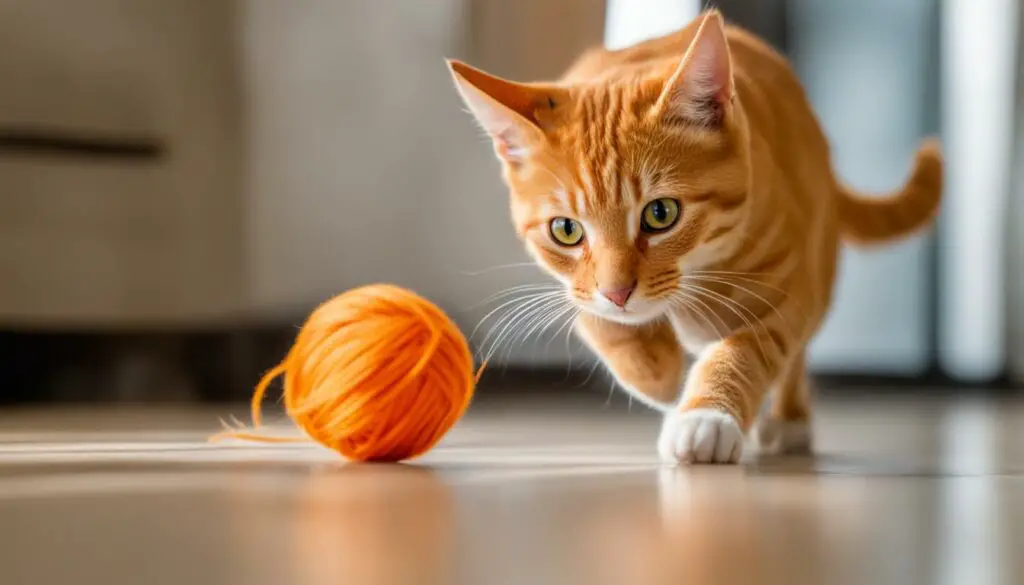After being spayed or neutered, most cats recover quickly and experience minimal behavioral changes. However, in rare instances, cats may become more active and energetic after the procedure. This can be attributed to the absence of reproductive hormones, which can result in increased energy levels. Understanding why your cat is very active after neutering can help you manage their behavior effectively.
Key Takeaways:
- Neutering can result in some cats becoming more active and energetic after the procedure.
- The absence of reproductive hormones can contribute to increased energy levels in neutered cats.
- Understanding why your cat is very active after neutering can help you manage their behavior effectively.
- Providing outlets for your cat’s energy through playtime and environmental enrichment is important.
- Proper post-neutering care, including monitoring the surgery site and providing emotional support, can help ensure a smooth recovery.
Common Cat Behavior Changes After Spaying
After being spayed, female cats may exhibit changes in behavior. These changes are typically temporary and may include sleeping more often, walking more slowly, jumping less, and eating less. These behaviors can be attributed to the sedative effects of anesthesia and pain medication used during the procedure. While these changes may be concerning, they are generally normal and should resolve over time as your cat fully recovers from the surgery.
However, it is important to keep an eye out for more serious signs that may indicate complications. If your cat experiences persistent bleeding, swelling, or extreme lethargy, it is crucial to seek veterinary intervention. These symptoms may indicate an infection or other complications that require immediate attention.
If you notice any concerning changes in your cat’s behavior after spaying and are unsure whether they are normal, it is always best to consult with your veterinarian. They can provide guidance and ensure that your cat is recovering properly.

Summary:
- Female cats may experience behavior changes after being spayed.
- Temporary changes may include sleeping more, walking slowly, jumping less, and eating less.
- These changes are typically due to the sedative effects of anesthesia and pain medication.
- Monitor for signs of complications and consult a veterinarian if necessary.
Common Cat Behavior Changes After Neutering
After being neutered, male cats may experience some changes in behavior. While most cats recover without any noticeable changes, some may become more active and display increased energy levels. This can be attributed to the absence of testosterone, which can reduce aggression and territorial behaviors in male cats. It is important to monitor your cat’s behavior and provide outlets for their increased activity.
Some common behavior changes observed in neutered male cats include:
- Increased playfulness and energy
- More frequent chasing and pouncing on toys
- Higher levels of curiosity and exploration
To help manage your cat’s increased activity, it is essential to provide them with appropriate outlets for their energy. Interactive toys, such as puzzle feeders and feather wands, can help engage your cat’s hunting instincts and provide mental stimulation. Regular playtime sessions can also help tire out your cat and prevent them from becoming bored or restless. Additionally, creating a cat-friendly environment with scratching posts, perches, and hiding spots can encourage physical activity and provide outlets for your cat’s natural behaviors.
Remember, every cat is unique, and individual behavior changes may vary. If you have any concerns or notice any excessive hyperactivity or behavior problems after neutering, it is always best to consult with your veterinarian for further guidance.
| Behavior Change | Description |
|---|---|
| Increased Playfulness | Neutered male cats may exhibit a higher level of playfulness, engaging in more interactive play sessions with their owners or toys. |
| Heightened Curiosity | Neutered cats may show increased curiosity about their environment, exploring new areas and investigating objects. |
| More Vocalization | Some male cats may become more vocal after being neutered, meowing or chirping more frequently to communicate their needs or seek attention. |
Quote: “Neutering can result in increased activity levels in male cats, as the absence of testosterone can reduce aggression and territorial behaviors.” – Veterinarian Dr. Jane Myers
How to Keep Your Neutered Cat Active
After being spayed or neutered, cats may experience increased energy levels. It is important to provide outlets for their energy and keep them active. Here are some tips to help keep your neutered cat active:
- Engage in interactive play sessions: Playtime is essential for keeping your cat active. Use toys that stimulate their natural hunting instincts, such as feather wands or interactive treat-dispensing puzzles.
- Provide engaging toys: Offering a variety of toys can keep your cat stimulated and prevent boredom. Rotate toys regularly to maintain their interest.
- Create a cat-friendly environment: Set up perches, scratching posts, and hiding spots to encourage physical activity. Cats enjoy climbing, scratching, and exploring their surroundings.
- Encourage exercise through feeding: Use puzzle feeders or food-dispensing toys to make mealtime more engaging. This encourages your cat to work for their food, providing mental stimulation and physical exercise.
Remember to start slow and gradually increase activity levels to avoid overwhelming your cat. Observe their behavior and adjust the intensity and duration of playtime accordingly. Keeping your neutered cat active not only helps manage their energy but also promotes their overall health and well-being.
How to Create a Cat-Friendly Environment
A cat-friendly environment plays a crucial role in keeping your neutered cat active. Here are some tips to create an engaging space for your feline friend:
- Provide elevated perches: Cats love to climb and observe their surroundings from higher vantage points. Install cat shelves or provide cat trees with multiple levels for climbing and lounging.
- Offer scratching posts: Scratching is a natural behavior for cats and helps keep their claws healthy. Place a sturdy scratching post or two in areas where your cat spends most of their time.
- Introduce interactive toys: Toys that stimulate your cat’s mental and physical abilities are essential. Examples include puzzle toys, treat balls, and laser pointers (used responsibly).
- Create hiding spots: Cats enjoy having cozy hiding spots where they can retreat and feel safe. Provide hiding spots such as covered beds, cat tunnels, or cardboard boxes.
By incorporating these elements into your cat’s environment, you can encourage them to stay active, engaged, and mentally stimulated.
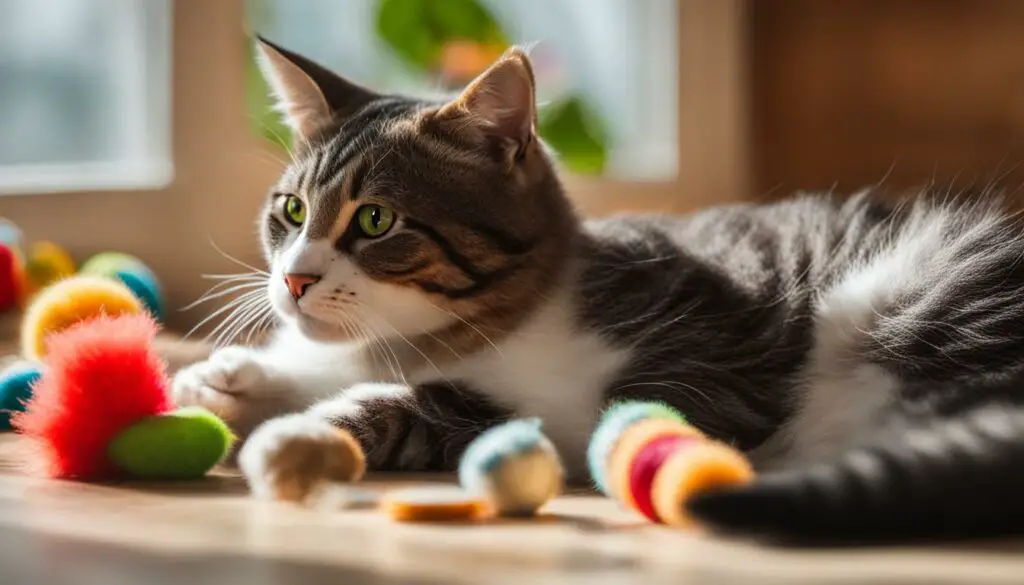
Tips for Post-Neutering Care

After your cat has been neutered, it is important to provide proper care to ensure a smooth recovery and manage their behavior. Here are some tips to help you take care of your cat after the neutering procedure:
1. Keep Your Cat Calm and Limit Physical Activity
During the initial recovery period, it is important to keep your cat calm and limit their physical activity. This will allow their body to heal and reduce the risk of complications. You can confine your cat to a quiet room with low-lying furniture to prevent them from jumping or climbing, which may strain the surgical site.
2. Monitor the Surgery Site for Signs of Infection
Regularly check the surgery site for any signs of infection, such as redness, swelling, or discharge. If you notice any abnormalities, contact your veterinarian for further evaluation. They may recommend additional treatments or medications to promote healing and prevent infection.
3. Follow Your Veterinarian’s Aftercare Instructions
Your veterinarian will provide specific aftercare instructions for your cat, including any recommended medications or ointments. It is important to follow these instructions carefully to ensure your cat’s well-being and a successful recovery. If you have any questions or concerns, don’t hesitate to reach out to your veterinarian for guidance.
By following these tips for post-neutering care, you can help your cat recover comfortably and manage their behavior effectively. Remember to provide a calm environment, monitor the surgery site, and follow your veterinarian’s instructions for the best possible outcome.
Importance of Indoor Environment After Neutering
Keeping your cat indoors after neutering is crucial for their safety and well-being. By providing a protected environment, you can prevent potential risks such as fights with other animals, accidents, or exposure to diseases. Additionally, an indoor environment offers stability and routine, which can help reduce stress and anxiety in cats. It also allows you to have better control over their activities and behavior, ensuring their overall health and happiness.
Indoor cats also tend to have a longer lifespan compared to outdoor cats. They are less likely to encounter hazards such as traffic, predators, or toxic substances. Indoor living also reduces the risk of injuries from fights or territorial disputes with other animals. By keeping your cat indoors, you can provide a safe and secure environment where they can thrive.
However, it is important to ensure that your indoor environment is enriching and stimulating for your cat. Engage them in regular play sessions using interactive toys to provide mental and physical stimulation. Create vertical spaces such as cat trees or shelves where they can climb and explore. Consider providing scratching posts to fulfill their natural instincts and prevent furniture damage. Providing hiding spots, such as cozy cat beds or boxes, can also offer a sense of security for your cat. By creating a cat-friendly indoor environment, you can help prevent boredom and encourage your cat to stay active.
| Benefits of Keeping Cats Indoors After Neutering |
|---|
| Increased Safety: Prevents exposure to hazards like traffic, predators, and diseases |
| Longer Lifespan: Indoor cats generally live longer and have reduced risks of injuries or accidents |
| Reduced Stress: Provides stability, routine, and control over the cat’s environment |
| Enriching Environment: Engagement in play, vertical spaces, scratching posts, and hiding spots |
Remember, each cat is unique, and their individual needs may vary. Some cats may be perfectly content with an indoor-only lifestyle, while others may thrive with supervised outdoor access in a secure and controlled manner. It is important to consider your cat’s personality, behavior, and any potential risks associated with outdoor access. Consult with your veterinarian to determine the most suitable environment for your cat after neutering.

Expert Tip: Encouraging Environmental Enrichment
To make your indoor environment even more enriching for your cat, try the following:
- Rotate and introduce new toys regularly to keep them engaged.
- Provide a variety of interactive toys that stimulate hunting and chasing behaviors.
- Set up puzzle feeders or treat dispensers to provide mental stimulation during mealtime.
- Create different levels and vertical spaces for climbing and exploring.
- Offer a comfortable and secluded resting area where your cat can retreat when they need some alone time.
“Keeping cats indoors after neutering not only ensures their safety but also provides them with a secure and stimulating environment where they can thrive.” – Dr. Emily Thompson, Feline Behavior Specialist
Monitoring the Surgery Site
After your cat’s neutering procedure, it is crucial to regularly monitor the surgery site for any signs of redness, swelling, or odor. These can indicate an infection or complication that may require veterinary attention. By keeping a close eye on the incision site, you can help ensure a smooth recovery for your furry friend.
Table: Signs to Watch for After Neutering
| Signs | Possible Complications |
|---|---|
| Redness | Infection |
| Swelling | Fluid accumulation or hematoma |
| Odor | Infection |
If you notice any abnormalities at the suture line, such as persistent redness or a foul odor, it is important to contact your veterinarian immediately. They can evaluate the situation and recommend appropriate treatment, such as antibiotics or additional wound care measures. Prompt intervention can help prevent further complications and promote optimal healing.
Remember to follow your veterinarian’s aftercare instructions carefully, including any recommended medications or ointments to apply to the surgical site. By providing proper wound care, you can minimize the risk of infection and support your cat’s recovery process. Regular monitoring and timely veterinary intervention are key to ensuring your cat’s well-being.
Using a Recovery Collar
After your cat has been neutered, it may be necessary to use a recovery collar to prevent them from licking or biting at the incision site. This is an important step in ensuring the healing process goes smoothly and minimizing the risk of infection. While some cats may initially resist wearing a recovery collar, it is important to follow your veterinarian’s instructions and ensure that your cat wears it as recommended.
The recovery collar serves as a protective barrier, preventing your cat from accessing the incision site and interfering with the healing process. It helps to keep the area clean and free from any contaminants that could lead to infection. By wearing the recovery collar, your cat can focus on resting and recovering without the added worry of injuring themselves.
To ensure a successful recovery, it is important to choose the right size recovery collar for your cat. It should be snug enough to prevent your cat from reaching the incision site, but not too tight to cause discomfort. Your veterinarian can provide guidance on selecting the appropriate size and fit for your cat.
Remember to monitor your cat while they are wearing the recovery collar to ensure they are comfortable and adjusting well. If you notice any signs of distress or discomfort, contact your veterinarian for assistance. With proper care and the use of a recovery collar, your cat’s post-neutering recovery can progress smoothly, allowing them to return to their normal activities in no time.
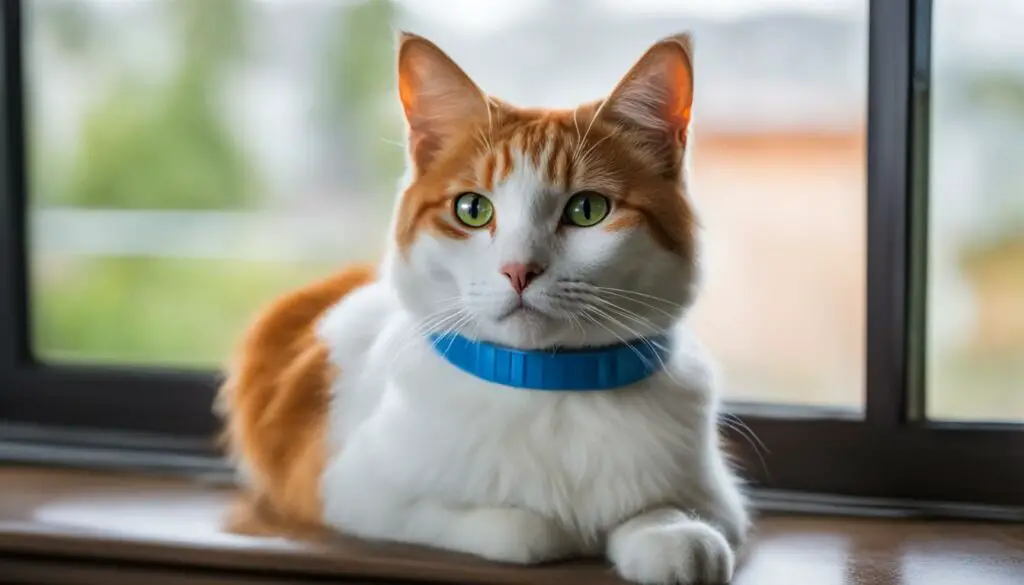
Benefits of Using a Recovery Collar:
- Prevents licking and biting at the incision site
- Minimizes the risk of infection
- Allows for uninterrupted healing
- Promotes a smooth recovery process
- Provides peace of mind for pet owners
How to Introduce the Recovery Collar to Your Cat:
- Choose the right size collar for your cat
- Introduce the collar gradually, allowing your cat to sniff and explore it
- Attach the collar securely, making sure it is comfortable and not too tight
- Monitor your cat’s behavior and adjust the collar if needed
- Provide extra love and attention to help your cat adjust to wearing the collar
Caring for Your Cat’s Emotional Well-being
After being spayed or neutered, cats may require some extra reassurance and attention. They may feel anxious or disoriented after the procedure and being in a new environment. Spending quality time with your cat, providing comfort and reassurance, can help alleviate any stress or anxiety they may experience. Offering familiar objects, such as their favorite toys or blankets, can also provide a sense of security and familiar scent.
It’s important to remember that each cat is unique, and their emotional response to neutering can vary. Some cats may be more sensitive and may need additional support during this time. Paying attention to their behavior and body language can help you gauge their emotional state and provide the reassurance they need.
Creating a calm and quiet environment for your cat can also contribute to their emotional well-being. Minimize loud noises and sudden changes in their surroundings. Provide a safe and comfortable space where they can retreat if they need some alone time.
Recognizing Signs of Stress
It’s essential to be aware of the signs of stress in your cat so that you can address their emotional well-being promptly. Common signs of stress include:
- Excessive grooming
- Loss of appetite
- Withdrawal or hiding
- Inappropriate urination or defecation
- Aggression or increased vocalization
If you notice any of these signs, it’s important to consult with your veterinarian for guidance. They can provide additional strategies to help manage your cat’s stress and anxiety.
Creating a Routine
Establishing a routine can be beneficial for your cat’s emotional well-being. Cats are creatures of habit and thrive on predictability. Set consistent feeding times, play sessions, and quiet periods for rest. This can help reduce their stress levels and provide a sense of security.
Additionally, incorporating interactive play into your cat’s routine can help them release pent-up energy and reduce anxiety. Engage them in stimulating activities such as chasing toys or using puzzle feeders. This not only provides mental stimulation but also strengthens the bond between you and your cat.
Seeking Professional Help
If you find that your cat’s emotional well-being is not improving or if their stress levels are severely impacting their quality of life, it may be beneficial to consult with a professional, such as a veterinary behaviorist. These experts can provide specialized guidance and develop a comprehensive plan to address your cat’s specific needs.
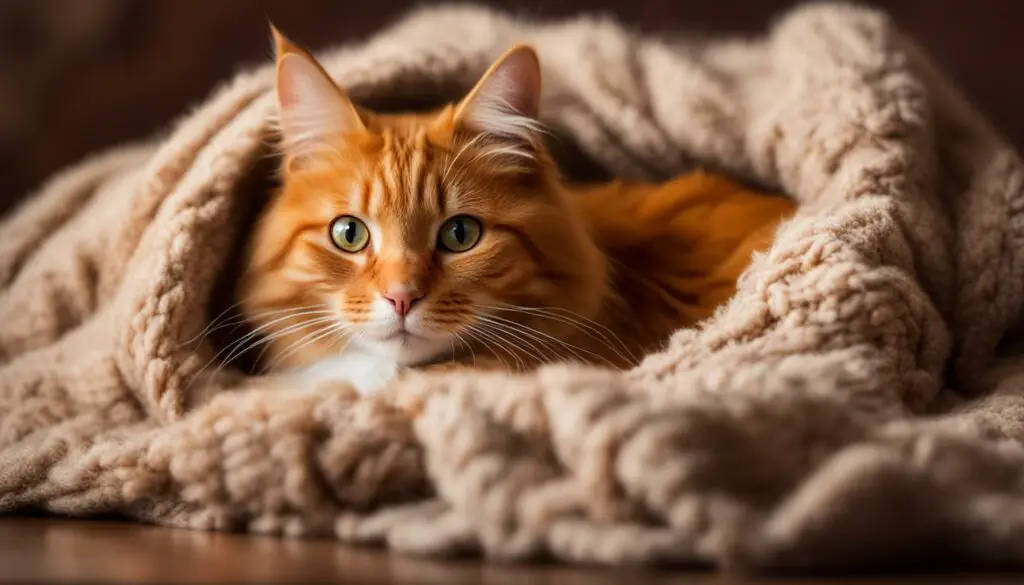
| Signs of Stress | Explanation |
|---|---|
| Excessive grooming | Cats may excessively groom themselves as a coping mechanism when they’re stressed or anxious. |
| Loss of appetite | Stress can cause cats to lose their appetite and avoid eating regularly. |
| Withdrawal or hiding | Cats may retreat to secluded areas or hide when they’re feeling stressed or overwhelmed. |
| Inappropriate urination or defecation | Stress can lead to cats urinating or defecating outside of their litter box as a sign of distress. |
| Aggression or increased vocalization | Cats may become more aggressive or vocal when they’re feeling stressed or anxious. |
Impact of Spaying and Neutering on Cat Behavior
Spaying and neutering have a significant impact on cat behavior. These procedures remove the reproductive hormones that can contribute to unwanted behaviors such as roaming, aggression, and spraying. By reducing or eliminating these hormones, spaying and neutering can help promote more balanced and manageable behavior in cats.
The absence of reproductive hormones, such as estrogen and testosterone, can lead to changes in a cat’s behavior after spaying or neutering. For example, male cats may become less aggressive and territorial. Without the influence of testosterone, they are less likely to engage in fights with other cats and mark their territory through spraying. This can create a more peaceful and harmonious environment for both the cat and their owners.
Female cats, on the other hand, may experience a reduction in behaviors associated with their reproductive cycle. Spaying eliminates the heat cycle, preventing the yowling, restlessness, and potential aggression that can occur during this time. It also significantly reduces the risk of certain reproductive disorders, such as uterine infections and mammary tumors. This not only benefits the cat’s behavior but also their overall health and well-being.
While spaying and neutering play a crucial role in shaping a cat’s behavior, it is important to note that behavior can also be influenced by genetics and socialization. Some cats may have a naturally more laid-back temperament, while others may be more energetic or prone to certain behaviors. Additionally, environmental factors and the cat’s individual experiences can also contribute to their behavior. By understanding the effects of spaying and neutering and providing appropriate care and guidance, cat owners can help their furry companions lead happy and balanced lives.
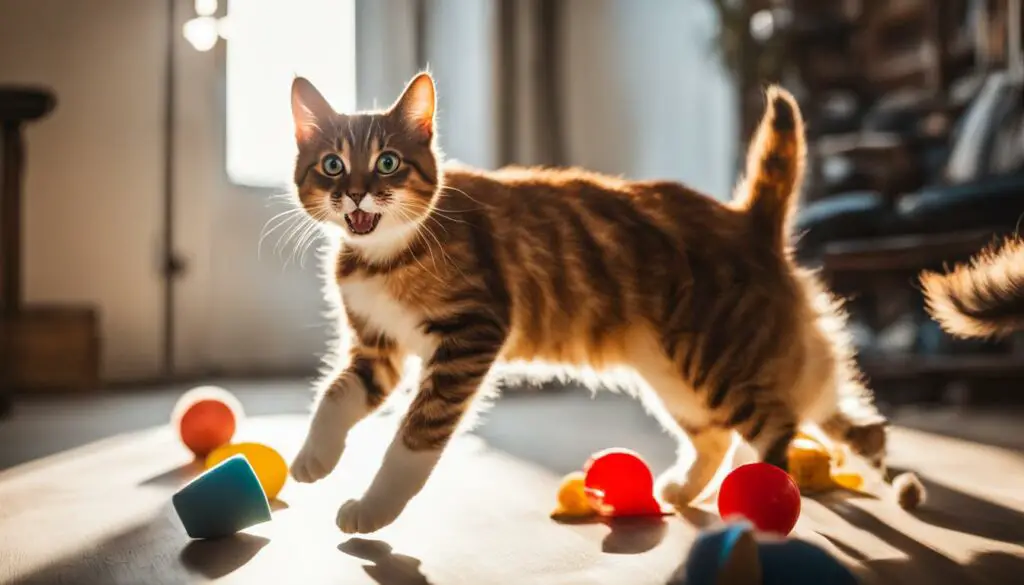
table {
width: 100%;
border-collapse: collapse;
}
table, th, td {
border: 1px solid black;
}
th, td {
padding: 8px;
text-align: left;
}
th {
background-color: #f2f2f2;
}
| Effects of Spaying and Neutering on Cat Behavior |
|---|
| Reduces aggression and territorial behaviors in male cats |
| Eliminates heat cycle and associated behaviors in female cats |
| Prevents spraying and marking behavior |
| Reduces the risk of reproductive disorders |
| Contributes to a more peaceful and harmonious household |
Unwanted Behaviors After Neutering
While spaying and neutering can help reduce unwanted behaviors in cats, it’s important to recognize that some cats may still exhibit certain behaviors after the procedure. These behaviors can vary in intensity and duration, but with patience and appropriate interventions, they can be managed effectively. Here are some common unwanted behaviors that may occur after neutering:
1. Roaming:
Some neutered cats may still have the instinctual urge to roam. This behavior can be influenced by factors such as breed, genetics, and previous experiences. To prevent roaming, ensure that your cat’s environment is enriching and stimulating. Provide plenty of interactive toys, scratching posts, and vertical spaces for climbing and exploration. Engaging your cat in daily play sessions can also help redirect their energy and reduce the desire to roam.
2. Spontaneous Urination:
Occasionally, neutered cats may exhibit spontaneous urine marking or inappropriate urination. This can be a result of residual hormonal influences or territorial behavior. If your cat is urinating outside of the litter box, it’s important to rule out any underlying medical conditions by consulting your veterinarian. Behavioral modifications, such as providing multiple litter boxes in different areas of the house and using pheromone sprays to reduce stress, can help address this issue.
3. Irritability and Aggression:
Some neutered cats may display irritability and aggression towards humans or other animals. This can be due to a variety of factors, including socialization, territorial disputes, or fear-based behaviors. It’s important to address aggression in cats promptly to prevent potential injuries and maintain a harmonious household. Consult with a professional animal behaviorist or your veterinarian for guidance on behavior modification techniques and strategies.
4. Unwanted Attention from Other Animals:
Neutered cats may still attract unwanted attention from intact cats or other animals in the neighborhood. This can lead to fights, territorial disputes, and potential injuries. To minimize the risk, ensure that your cat’s outdoor environment is secure and inaccessible to other animals. Consider using deterrents such as motion-activated sprinklers or sonic devices to discourage intruders. If necessary, consult with your veterinarian about the possibility of using deterrent medications or pheromones to reduce your cat’s attractiveness to other animals.
Remember, each cat is unique, and their behavior after neutering may vary. If you have concerns about your cat’s behavior or are struggling to manage certain unwanted behaviors, don’t hesitate to seek guidance from your veterinarian or a professional animal behaviorist. With proper care, attention, and understanding, you can help your cat adjust to their new post-neutering life and minimize any unwanted behaviors.

How to Care for Your Cat’s Emotional Well-being After Neutering
After neutering your cat, it’s important to provide them with the emotional support they need for a smooth recovery. Here are some tips to help care for your cat’s emotional well-being after spaying or neutering:
1. Reassurance and Attention
Your cat may feel a bit anxious or disoriented after the procedure, so it’s essential to offer them extra reassurance and attention. Spend quality time with your cat, petting them gently and talking to them in a soothing voice. This will help alleviate any stress or anxiety they may experience.
2. Familiar Objects and Scents
Providing familiar objects, such as their favorite toys or blankets, can offer a sense of security to your cat. These objects carry their familiar scent, which can help them feel more comfortable and at ease in their post-neutering environment.
“Offering familiar objects and creating a routine can help alleviate restlessness or anxiety your cat may experience after neutering.”
3. Playtime and Mental Stimulation
Engaging in playtime with your cat is not only a great way to bond but also helps to keep their minds stimulated. Use interactive toys or engage in gentle play sessions to keep them active and occupied. This will help distract them from any discomfort they may be feeling and promote a positive emotional state.
| Benefits of Emotional Care After Neutering | How to Provide Emotional Care |
|---|---|
| Reduces stress and anxiety | Offer reassurance and attention |
| Promotes faster recovery | Provide familiar objects and scents |
| Strengthens the bond between you and your cat | Engage in playtime and mental stimulation |
By following these tips and providing emotional care, you can help your cat feel safe and supported during their recovery after neutering. Remember, each cat is unique, so it’s important to observe their individual needs and adjust your approach accordingly.
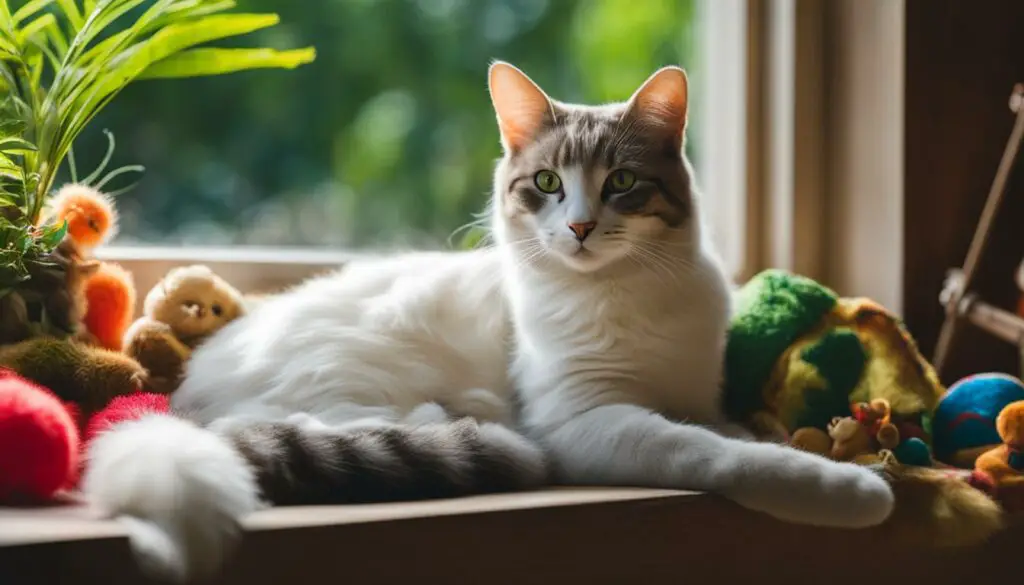
Recovery Period for Male Cats After Neutering
After being neutered, male cats typically have a shorter recovery period compared to females. While the exact time can vary from cat to cat, most male cats will start to feel better within 24-48 hours after the procedure. During this time, it is normal for your cat to experience some discomfort, lethargy, and the lingering effects of anesthesia. However, these side effects should gradually subside as your cat’s body adjusts to the changes.
To help your male cat recover comfortably, it is important to limit their physical activity during the initial recovery period. This will allow their body to heal and reduce the risk of complications. Providing a quiet and comfortable space for your cat, with low-lying furniture and minimal disturbances, can help facilitate their recovery. It is also essential to monitor the incision site for any signs of infection, such as redness, swelling, or discharge.
If your male cat appears to be in significant pain or discomfort, or if there are any concerning signs such as persistent bleeding or discharge, it is important to contact your veterinarian for guidance. They may prescribe pain medication or recommend additional measures to ensure your cat’s recovery is smooth and problem-free.
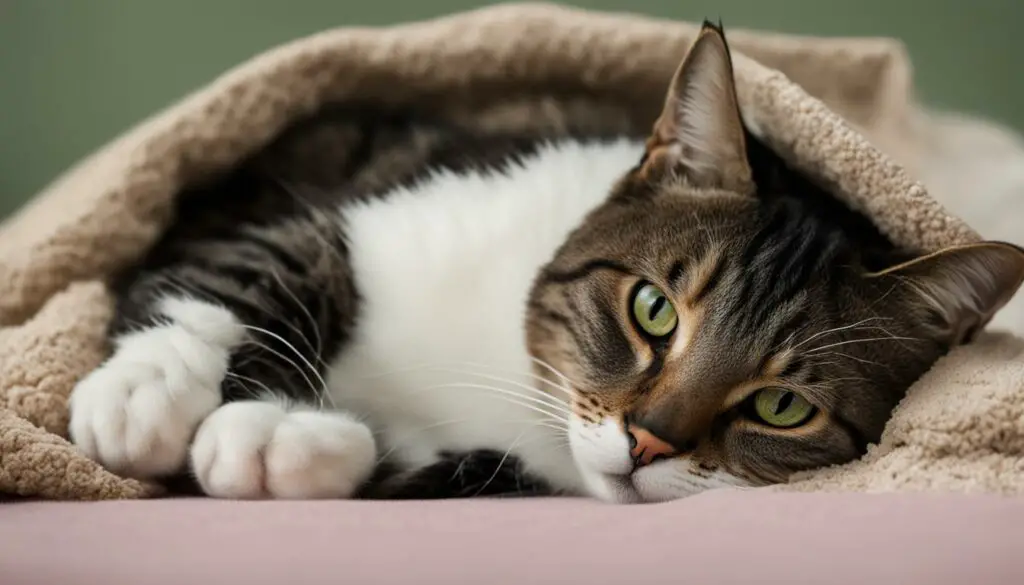
Overall, with proper care and monitoring, most male cats recover well from neutering and return to their usual activities within a few days. However, every cat is unique, and it is important to follow your veterinarian’s instructions and monitor your cat’s progress closely to ensure a successful recovery.
Signs to Watch for After Neutering Your Cat
After your cat has been neutered, it’s important to monitor their recovery and watch for any signs of complications. While neutering is generally a safe procedure, there is a small risk of post-surgery issues that may require veterinary attention. By being vigilant and knowing what to look for, you can ensure your cat’s health and well-being during their post-neutering recovery.
Signs of Surgical Complications
One of the crucial signs to watch for after your cat has been neutered is any redness, swelling, or discharge around the incision site. These can be signs of infection or wound dehiscence, which is when the surgical incision reopens. If you notice any abnormal or concerning changes in the appearance of the incision, it’s important to contact your veterinarian for further evaluation and guidance.
Another potential complication to watch for is excessive bleeding. While some bleeding immediately after the surgery is normal, it should subside within a few hours. If you notice persistent bleeding or the development of a hematoma (a localized collection of blood), it’s essential to seek veterinary attention. Excessive bleeding can be a sign of a surgical complication that requires medical intervention.
Post-Neutering Recovery
During your cat’s recovery period, it’s important to be aware of their overall well-being. Keep an eye out for signs of discomfort, such as excessive licking or biting at the incision site, restlessness, or decreased appetite. While some level of discomfort is normal after surgery, any signs of prolonged or severe discomfort should be addressed by your veterinarian.
Additionally, monitor your cat’s overall activity level. While it’s normal for cats to be less active during the initial recovery period, any extreme lethargy or refusal to move should be investigated. Pay attention to their bathroom habits as well. Difficulty urinating or defecating, or a complete lack of urination or defecation, can be signs of complications and should be promptly addressed by a veterinarian.
| Signs of Surgical Complications | Post-Neutering Recovery |
|---|---|
| – Redness, swelling, or discharge around the incision site | – Excessive licking or biting at the incision site |
| – Excessive bleeding or development of a hematoma | – Restlessness or decreased appetite |
| – Extreme lethargy or refusal to move | |
| – Difficulty urinating or defecating |
By closely monitoring your cat’s recovery and promptly addressing any signs of complications, you can help ensure a smooth healing process. Remember to follow your veterinarian’s aftercare instructions and provide a calm and comfortable environment for your cat’s post-neutering recovery.
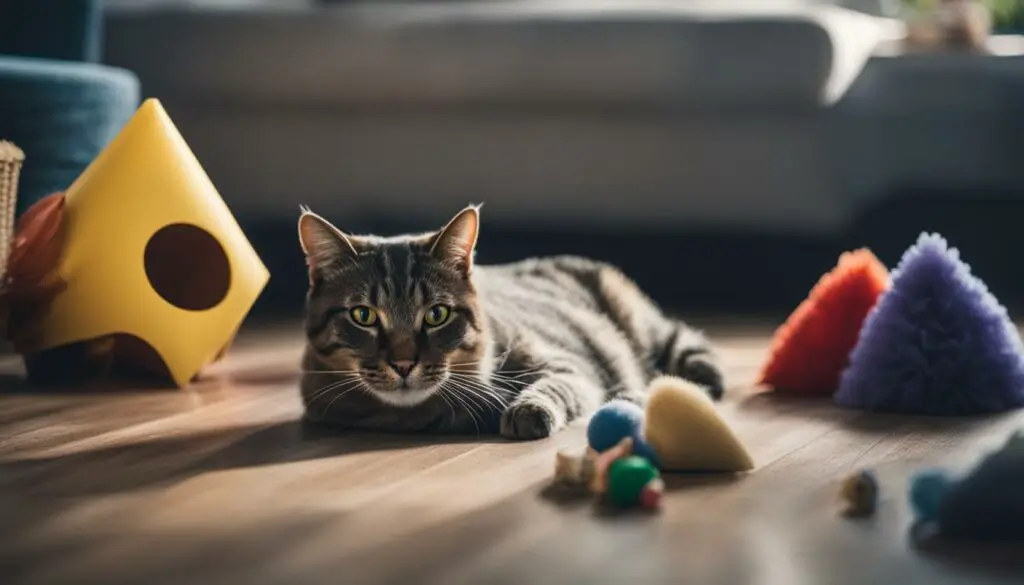
Conclusion
Managing your cat’s behavior after neutering is essential for their well-being. While most cats recover quickly and experience minimal changes, some may become more active and energetic. Understanding this behavioral shift can help you provide the necessary outlets for their energy.
Engaging your cat in interactive play sessions and offering stimulating toys can help keep them active and prevent boredom. Creating an enriching indoor environment with perches, scratching posts, and hiding spots can also encourage physical activity.
Additionally, post-neutering care is crucial for a smooth recovery. Monitor the surgery site for any signs of infection or complications, and follow your veterinarian’s aftercare instructions. Providing emotional support by spending quality time with your cat and offering reassurance can also help alleviate any stress or anxiety they may experience.
By understanding and managing your cat’s behavior after neutering, you can ensure they lead a happy and healthy life. Remember to consult with your veterinarian if you have any concerns or questions about your cat’s post-neutering behavior.
FAQ
Is it normal for a cat to be very active after neutering?
Yes, in some cases, cats may become more active and energetic after being neutered. This can be attributed to the absence of reproductive hormones, which can result in increased energy levels.
What behavioral changes can I expect in my female cat after spaying?
After being spayed, female cats may sleep more often, walk more slowly, jump less, and eat less. These changes are typically temporary and are often attributed to the sedative effects of anesthesia and pain medication.
Can male cats become more active after being neutered?
Yes, while most male cats recover without noticeable changes in behavior, some may become more active and display increased energy levels. This can be due to the absence of testosterone, which can reduce aggression and territorial behaviors.
How can I keep my neutered cat active?
To keep your neutered cat active, you can engage in interactive play sessions, provide engaging toys, and offer opportunities for exploration. Creating a cat-friendly environment with perches, scratching posts, and hiding spots can also encourage physical activity.
What should I do to care for my cat after neutering?
After neutering, it is important to keep your cat calm and limit their physical activity during the initial recovery period. Confining them to a quiet room with low-lying furniture, monitoring the surgery site for any signs of infection, and following your veterinarian’s aftercare instructions are essential.
Why is it important to keep a neutered cat indoors?
Keeping your cat indoors after neutering is crucial for their safety and well-being. It prevents them from engaging in risky behaviors such as roaming, fighting with other cats, or getting into accidents. It also helps prevent them from becoming bored and exhibiting excessive energy.
How should I monitor the surgery site after my cat’s neutering procedure?
It is important to regularly check the surgery site for any signs of redness, swelling, or odor, as these may indicate an infection or complication. If you notice any abnormalities, it is important to contact your veterinarian for further evaluation.
Should I use a recovery collar for my cat after neutering?
Your veterinarian may recommend using a recovery collar to prevent your cat from licking or biting at the incision site. This can help protect the surgical area and prevent infection. It is important to follow your veterinarian’s instructions regarding the use of a recovery collar.
How can I care for my cat’s emotional well-being after neutering?
After being spayed or neutered, cats may require extra reassurance and attention. Spending quality time with your cat, providing comfort and reassurance, and offering familiar objects such as toys or blankets can help alleviate any stress or anxiety they may experience.
What impact does spaying and neutering have on cat behavior?
Spaying and neutering remove the reproductive hormones that can contribute to unwanted behaviors such as roaming, aggression, and spraying. By reducing or eliminating these hormones, spaying and neutering can help promote more balanced and manageable behavior in cats.
What are some common unwanted behaviors cats may exhibit after neutering?
Some common unwanted behaviors after neutering can include roaming, spontaneous urination, irritability, aggression, bleeding, and unwanted attention from other animals. These behaviors can be addressed through positive reinforcement training, environmental enrichment, and consulting with your veterinarian if necessary.
How can I care for my cat’s emotional well-being after neutering?
To care for your cat’s emotional well-being after neutering, offer extra attention, reassurance, and playtime. Creating a routine and providing mental stimulation through interactive toys and games can help alleviate any restlessness or anxiety your cat may experience.
How long does it take for a male cat to recover from neutering?
Male cats typically have a shorter recovery period after neutering compared to females. They may experience some discomfort, lethargy, and anesthetic effects immediately after the procedure, but these side effects usually subside within 24-48 hours.
What signs should I watch for after neutering my cat?
After neutering your cat, it is important to monitor for any signs of complications such as redness, swelling, discharge, or signs of infection. Additionally, if your cat is experiencing persistent vomiting, lethargy, lack of appetite, or difficulty urinating or defecating, seek veterinary attention.

